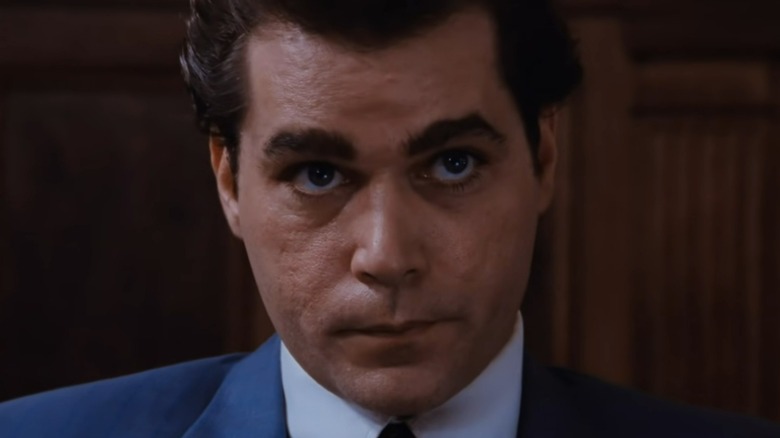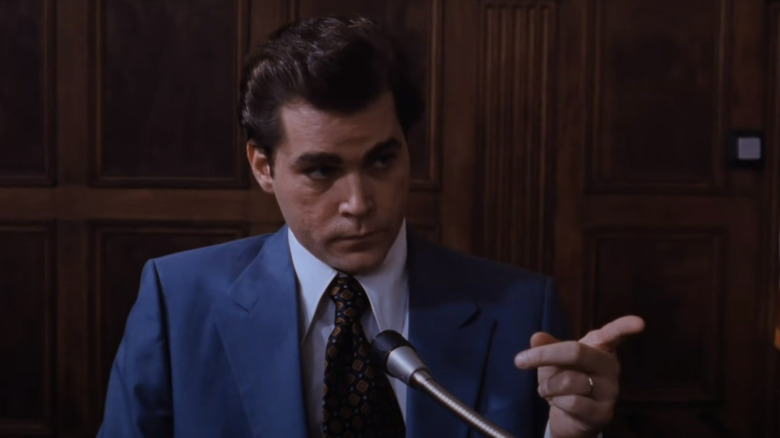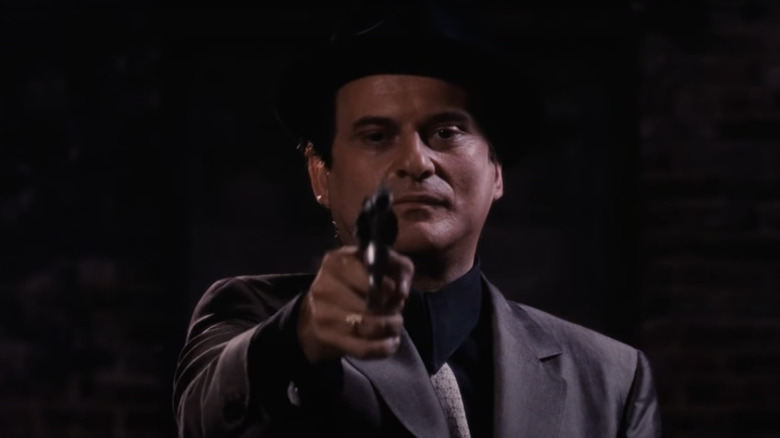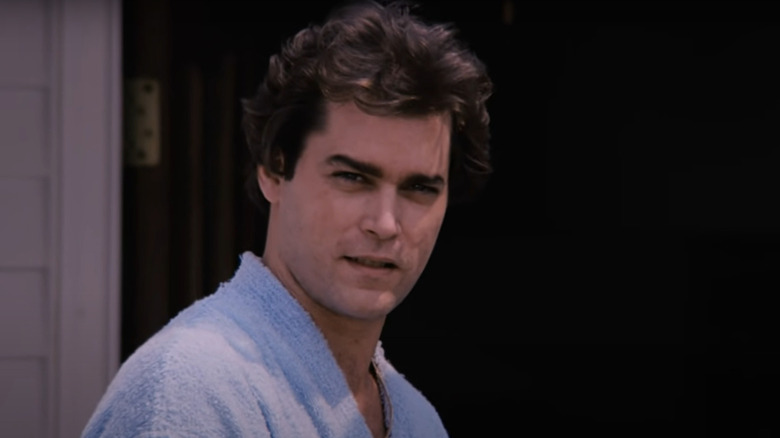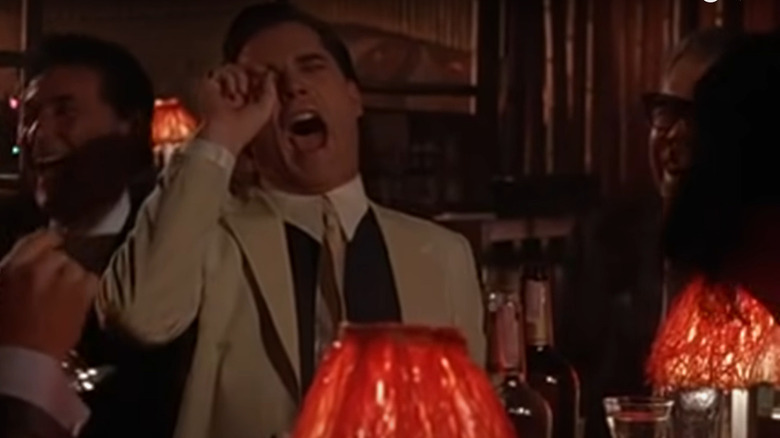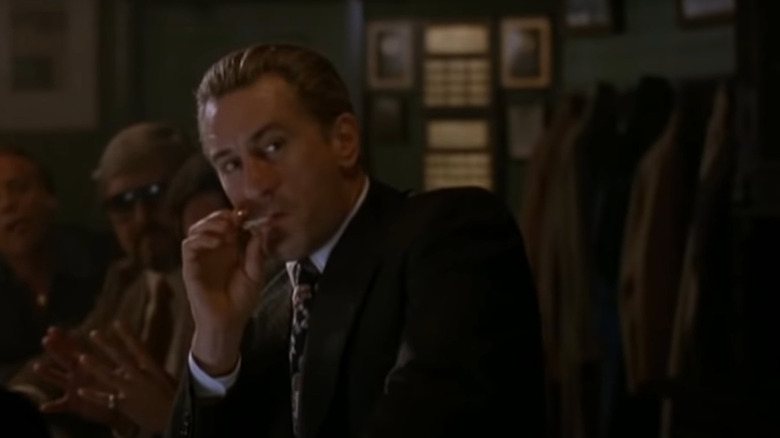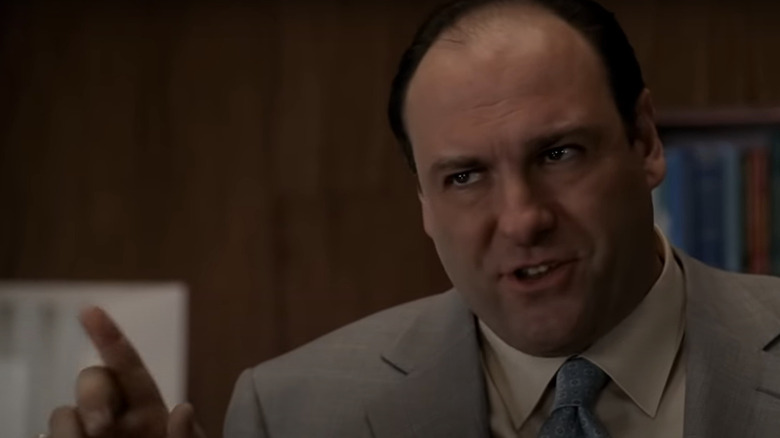The Ending Of Goodfellas Explained
On September 19, 1990 director Martin Scorsese unleashed his mob masterpiece "Goodfellas" on to the masses, and it is now widely regarded as one of the greatest films of all time. Based on the book "Wiseguy" by Nicholas Pileggi, "Goodfellas" recounts the life and times of Henry Hill, a mob associate whose testimony put high level gangsters behind bars. However, a straightforward description doesn't do the masterful yarn Scorsese spins any justice.
Scorsese takes a marathon of criminal enterprise — spanning from the 1950s to the 1980s — and turns it into a breathless sprint. Scorsese also makes decades of wrongdoing look fun. The movie takes off like a rocket and the audience is swept up in the power, decadence, and thrill that comes with skirting every rule of polite society. This is why the ending lands like a gut punch. Scorsese spends the last act of his film reminding everybody that eventually all rockets land and no action is without consequence. So in an effort to unpack the hard hitting finale, this is the ending of "Goodfellas" explained.
It's a rats world
In the world of the mafia, nothing is worse than being a rat. In other words, there's no bigger taboo than becoming a witness for the authorities aiming to take down organized crime syndicates. So some viewers may wonder why Ray Liotta's Henry Hill turns on his adopted felonious family at the end of "Goodfellas."
Essentially, Hill turned rat to survive. After three decades of working with the mob, Henry is cut off when he gets arrested for trafficking cocaine — a criminal trade specifically forbidden by mob boss Paul Cicero. After his arrest and subsequent ousting, his long time partner in crime and supposed friend, Jimmy "The Gent" Conway, attempts to have Henry and his wife Karen whacked. Out of money and friends, Henry turns to the only organization that will have him: the Federal Bureau of Investigation.
His sworn testimony puts both Jimmy and Paul behind bars and serves as Scorsese's final word on the titular "goodfellas" the audience spent the film with. In the end, Henry's testimony isn't proof that crime doesn't pay — the movie shows just how well it can. It's proof that living without any morals only ends in pain, isolation, or prison. Henry's choices backed him into a corner and Scorsese makes sure the audience knows Henry had to chew his way out like a rat to see another day.
Shooting for historic lineage
Some viewers may be confused by the shot of Joe Pesci's Tommy DeVito firing directly into frame that Scorsese stitched into the closing monologue. DeVito is dead — murdered for his unsanctioned whacking of made man Billy Bats — and because the image is seemingly unrelated to Hill's final address to the audience. However, the image is there for a reason.
In an interview with AFI, Scorsese explains the shot is a homage to 1903's "The Great Train Robbery." The movie — about a gang who holds up a steam engine — is famous for being one of the first narrative films. Like "Goodfellas," the silent film ends with a shot of one of the gang firing a revolver directly into the screen.
Scorsese tells AFI he included the shot because "Goodfellas" and the "Great Train Robbery" are both representative of popular culture's fascination with outlaws. He also notes the film's plots are virtually the same. Both movies follow groups of outlaws who get away with big scores before killing each other or being apprehended by the law. All this history means DeVito firing into frame is no random stylistic flourish. Instead, Scorsese uses the shot to connect "Goodfellas" to the long film tradition of rooting for the bad guys — until the law comes crashing down on their heads.
The schnook at the end of the road
In an interview with Film Comment (via Cinephilia & Beyond), Scorsese said he didn't believe the mafiosos in "Goodfellas" thought about their actions. To capture this on screen, he tried to make them "as primitive as possible. Just straight ahead. Want. Take. Simple." This approach to the characters explains the parallel between the film's opening and closing scenes.
During the opening scene, Henry's narration begins with the line "As far back as I can remember, I always wanted to be a gangster." Following this line, Henry closes the trunk of a car, the frame zooms and freezes on his face, and then Tony Bennett's "Rags to Riches" roars over the movie's titles.
In the final scene of the film, before title cards and credits roll, Henry ends his narration saying "I'm an average nobody. Get to live the rest of my life like a schnook." He then enters the home the FBI placed him in and closes its door on the viewers.
The parallels between the narration's open and its close mirror the audiences' journey with Henry. At the beginning, audiences are thrust into the car with Henry as he drives down the road to being a gangster. At the end, Henry leaves the audience outside his new life and home. He was a gangster, now he is a schnook. The ride's over and Henry is out of the life he loved.
He did it his way
"Goodfellas" has one of the all time great movie soundtracks. Scorsese's song choices underscore mood and time period throughout the film. It also helps that Scorsese's ear for music seems to be as strong as his eye for shots. For example, in "Goodfellas," he pairs the melancholic second half of Derek and the Domino's "Layla" with a murder montage. It's an all time stroke of genius.
However, the majority of the film's song choices are radio hits from their respective decades. So some viewers may wonder why Sid Vicious' cover of Frank Sinatra's "My Way" closes out the film. It's from the decade when the film ends, but its punk edge breaks away from the sounds of the movie's pop and rock motif.
Scorsese, in an interview with Film Comment (via Cinephilia & Beyond), said he felt the reason he chose the song seemed "pretty obvious," given the song's ironic take on the original's meaning. The characters in "Goodfellas," certainly lived life their way. But unlike Sinatra's original recording, the mobsters unique approach to life did not bring them to triumphant heights. Instead, their actions left them imprisoned, murdered by their peers, or rotting anonymously in a suburb.
Throughout the film Henry brags about the lack of responsibility afforded to gangsters. They don't pay taxes, endure commutes, or believe in "good government b*******." But this comes with a heavy price and Vicious' "My Way" underscores its cost brilliantly.
The real fellas behind Goodfellas
"Goodfellas" is based on the life and times of real mob associate Henry Hill, whose story was recorded in Nicholas Pileggi's book "Wiseguy." Scorsese tweaked some of Henry's story when bringing it to the big screen. For example, the movie never identifies which specific crime family the Hill and his friends were associated with. In reality, Henry, Jimmy, and Tommy, worked with the Lucchese crime family under caporegime Paul Vario.
Vario is portrayed as Paul Cicero in the film, and he's not the only character to receive a name change. Tommy DeVito was modeled after Tommy DeSimone. Jimmy Conway was based on James Burke. In an interview with the Tampa Bay Times following Henry Hill's death, Henry's sister Lucille Chrisafulle claimed James Burke was demonstrably worse in real life.
The movie also cut some real life events. For example, in his memoir "Gangsters and Goodfellas," Henry claims his wife slept with boss Paul Vario while Henry was in jail. Also, the movie does not include James Burke's role in a Boston College basketball point shaving scandal. Henry's testimony led to Burke's original 12 year prison sentence. During his term, Burke was convicted of murder and given another sentence of 20 years to life. Given the finite runtime of a film and the laundry lists of misdeeds committed by the characters it's based on, it's no wonder Scorsese shaved away some details to fit his vision into one movie.
Immeasurable impact
"Goodfellas" changed how gangsters and criminals were depicted in American entertainment, and is considered one of the best mob movies of all time. In his 1990 review, famed critic Roger Ebert even said, "No finer film has ever been made about organized crime — not even 'The Godfather.'" However, burrowing into the popular culture consciousness of movie fans everywhere is not the movie's only major achievement. It's also been cited as a source of inspiration for arguably the greatest show of all time: "The Sopranos."
In an interview with Peter Bogdanovich (who played therapist Dr. Elliot Kupferberg on the show), "Sopranos" creator David Chase said the movie was a major inspiration for his show. He specifically cited the humor that arose during scenes when the hardened criminals were simply hanging out. The odd blend of absurdism and violence in "Goodfellas" that colors scenes like Spider's shooting or the late night dinner with Tommy's mom can be felt in virtually every episode of "The Sopranos."
While making a movie that's been called perfect by critics is no small feat, it's even more impressive to inspire the show that kicked off the prestige TV movement. Because of its impact, "Goodfellas" won't be sleeping with the fishes anytime soon. For fans everywhere, firing up another re-watch of "Goodfellas" is as good as Vinnie's tomato sauce.
